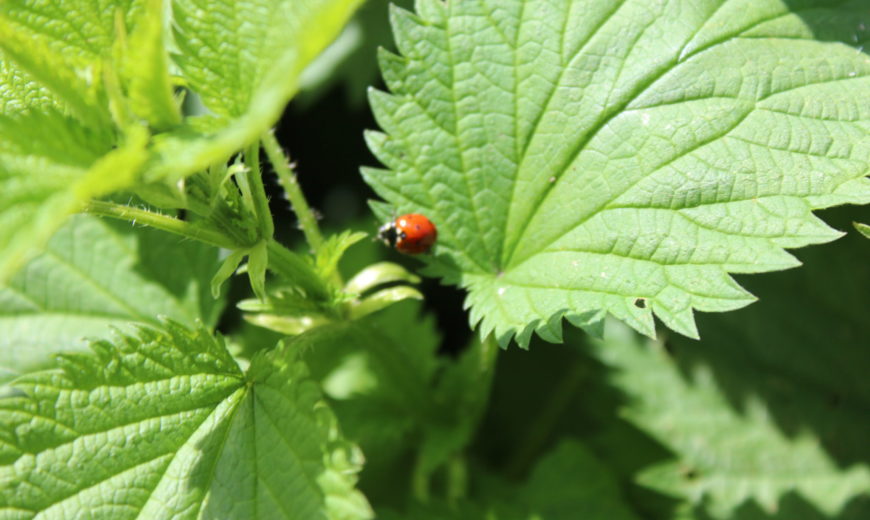Springtime Wild Plants in our Gardens

This time of year there are so many wonderful herbs just starting to spring up in our area, and many in our gardens. When I first started gardening at Rock Point I was told that my plot had been neglected for some time. But what I was very excited to find throughout the growing season was a wonderful plethora of wild-growing edible and medicinal plants! Included among them were:
- Yarrow – leaves and flowers have many medicinal effects, including being helpful for colds and flus and for wound healing.
- Mullein – leaves are very soothing for a dry, irritated cough
- Dandelion – leaves and flowers are edible, root makes a tea that supports digestion and the liver
- Plantain – wound healing and nourishing to the skin
- Motherwort – a relaxing herb that “mothers the mothers”
And even more, including lemon balm, comfrey, lambsquarters, amaranth, borage, mint, and queen anne’s lace. And that isn’t even all!
For this article I wanted to highlight one plant that I was particularly excited about, and which is a favorite for this time of year: nettles.
Stinging Nettle
Urtica dioica
Stinging nettle (a.k.a. “nettles”) is a relatively common plant in parts of Burlington, and does tend to like areas where people garden. It is considered by some to be a nuisance plant, since it quite vigorously spreads via rhizomes and can easily become dominant. However, with care and attention it’s possible to allow this plant its space and to cultivate a mutually nourishing relationship with it.
This plant is known for its sting, but it’s also incredibly nutritious and has medicinal properties as well. It contains calcium, potassium, magnesium, iron, silica, protein as well as vitamins A, C, K and multiple B vitamins. Many people use preparations from the fresh leaf to provide support for seasonal allergies, such as by making a tincture of the fresh leaves.
For those that may be wondering, have no worry about the sting! The harmless swellings and prickly sensations that may appear after contacting skin to the leaf or stem is caused by small hairs on the plant which inject a chemical into our skin. These hairs are de-natured quite easily by cooking or drying (dry leaves occasionally have a small sting). Harvest and process with care, i.e. by wearing gloves and there is no cause for concern.
You can harvest the leaves at any point before it goes to flower a bit later in the spring (at that stage they may have too much silica). I wait until it’s a couple feet tall then cut it down a few sets of leaves and potentially get a few harvests before it goes to flower. Another method would be to let it grow quite full and tall and then it is cut down to the ground completely and you can get another full harvest or 2 later in the season after it grows back.
After harvesting some leafy stems, your main options I’d say are to eat it, dry the leaves for tea, or to tincture the leaves. In any case, the first step is to remove the leaves from the stems (time for gloves!).
For cooking, you can simply use the greens much like spinach or other cooking greens. They are relatively tender, but do have a rougher texture than our cultivated plants. A short amount of time (maybe 5-10 seconds or so) in boiling water is all it takes to denature the sting. Many people like to cook it into soups or pesto. Cooking times are similar to spinach, maybe a bit longer.
For drying, you can simply hang the branched stems from a string hung up in your house, or lay them on a screen or even just a paper bag, allowing for as much airflow as possible and avoiding direct sunlight. Look for a leaf that crumbles easily in your fingers to know it’s done.
The dry leaves can make a wonderful nourishing infusion – use a small handful in a quart of hot water, let sit overnight and in the morning you will be surprised to see how dark and rich an infusion you get, a deep, rich brown or sometimes a wonderful vibrant dark green. Alternatively you can use 1 tablespoon per cup of hot water and steep 20-30 minutes for an individual cup of tea.
So if you happen to find nettles or some of the others mentioned in your garden plot, I hope you can not just see it as a “weed,” but instead see a potential new plant friend to get to know!
About the Author:
Nick works at Railyard Apothecary in Burlington, an herb store and herbal clinic. He started gardening at Rock Point in the spring of 2020. Feel free to contact with questions at nick@railyardapothecary.com.
